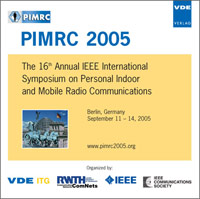A MIMO Mobile-to-Mobile Channel Model: Part II - the Simulation Model
Konferenz: PIMRC 2005 - 16th Annual IEEE International Symposium on Personal Indoor and Mobile Radio Communications
11.09.2005 - 14.09.2005 in Berlin, Germany
Tagungsband: PIMRC 2005
Seiten: 6Sprache: EnglischTyp: PDF
Persönliche VDE-Mitglieder erhalten auf diesen Artikel 10% Rabatt
Autoren:
Hogstad, Bjørn Olav; Pätzold, Matthias (Faculty of Engineering and Science, Agder University College, Grooseveien 36, 4876 Grimstad, Norway)
Youssef, Neji (Ecole Supérieure des Communications de Tunis, Route de Raoued, Km 3.5, 2083 El Ghazala, Tunis, Tunisia)
Kim, Dongwoo (Department of Electrical Engineering and Computer Science, Hanyang University, 1271 Sa-dong, Ansan, Kyeong-gi, 425-791 Korea)
Inhalt:
In this paper, we propose a multiple-input multiple-output (MIMO) mobile-to-mobile channel simulation model derived from a non-realizable reference model presented in Part I of our paper. The underlying reference model is based on the geometrical two-ring scattering model, where both the transmitter and the receiver are moving. A closed-form solution is provided for the three dimensional (3-D) space-time cross-correlation function (CCF) of the simulation model. An important result is that this CCF is ergodic. Also, our results show that this 3-D function can be expressed as a product of two 2-D space-time CCF, called the transmit and the receive CCF. It is shown that the parameters of the simulation model can be determined for any given space-time CCF describing the reference model. In case of isotropic scattering, we present a closed-form solution of the model parameters and illustrate some numerical results for the transmit and receive CCF. Finally, simulation results show an excellent correspondence between the statistical and time average of the MIMO channel capacity. This supports the hypothesis that the MIMO capacity is ergodic with respect to the mean.


